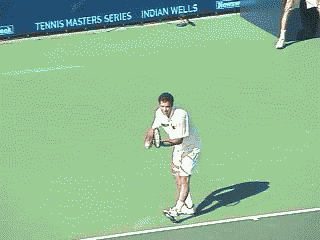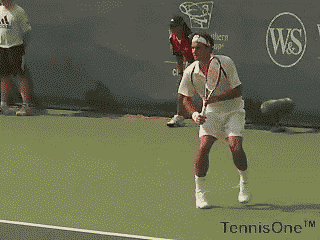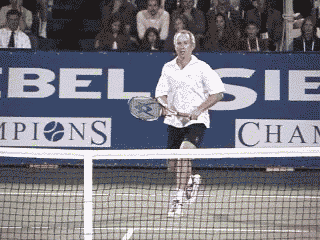|
TennisOne Lessons Relaxed Hands and Good Technique Daryl Fisher Exploring the relationship between keeping your hands relaxed and using good technique will help you reach your tennis potential. In fact, if you have read and applied the two previous articles on the topic of relaxing your hands while playing tennis (Relaxed Hands and Relaxed Hands Part II), then you might have noticed that your technique is improving while you are only paying attention to the tension in your hands. If you have not been able to hit your strokes with relaxed hands, however, there is something wrong, and the problem might be with your technique. (The problem might also be mental, and I will address this topic in a forthcoming article.)
Technique Every player needs to master a minimum of technique. Players with poor technique can be successful, but only within limits. Perhaps the most important of the potential limitations of poor technique is that it often leads to injuries. Poor technique also limits how easily and efficiently a player can handle and generate power. And while good technique and consistency are not necessarily correlated, good technique can help given that some motions can encourage better timing than others. For example, more compact and simpler motions are preferred because longer and more complex motions often do not hold up as well under the pressures of competitive match play. Technique check If you have hit a shot while keeping your hands relaxed, then there is a very good likelihood that you used good technique for that shot. With few exceptions, to be able to keep your hands relaxed while hitting a stroke is a good verification that you did a long list of things correctly. For example, in order to be able to consistently keep your hands relaxed while hitting a tennis ball, you must have a good grip, you must make contact with the ball with your arm and racquet in a stable alignment, you must have prepared sufficiently early, and you must have followed through sufficiently. If you fail in any one of these areas, then excess tension will almost certainly result and you will feel strain and effort in your hands, and probably in other parts of your body as well.
As part of the exploration of the interconnection between relaxed hands and good technique, try to prepare late without having a lot of strain in your hand and arm. Assuming that the oncoming ball has any speed at all, you will not be able to avoid excess tension. The fast and jerky back and forth motion of late preparation requires tension in order to stop the momentum of the racquet moving backward so that the racquet momentum can be changed to move forward. Benefits to technique Relaxed hands can help improve your technique beyond simply providing a checking method, but the improvement is not always immediate. Many people that try to relax their hands initially lose some power on their shots. This loss of power signals that they were using their arms for power. Beginner strokes often use the arms for power because beginners do not yet understand that the arms are a poor source of power compared to what the rest of the body can do with much less effort. Players with advanced strokes use the larger muscles of the legs and the torso and so make less effort to generate more power. In fact, for ground strokes, the arms are such poor sources of power compared to the power that comes from the legs and torso that the arms barely need to be used at all. Part of the insight of the classic book The Inner Game of Tennis by W. Timothy Gallwey is that the method of improvement that he presents makes things simpler for the conscious mind and leaves the subconscious mind to figure out the rest, which it generally does with a surprising amount of success. One of the secrets of the best tennis instructors is that they often give less attention to adding things to your game and more to removing extraneous obstacles in your path to improvement.
So keeping your hands relaxed might result in an initial loss of power on your shots, but if you persist with relaxed hands you may find that your body seeks out efficiencies in the motion so as to be able to hit harder and harder while still keeping the hands relaxed. Remember that power in tennis comes from racquet head speed. Racquet head speed does not require much use of the hands or arms at all. If you are able to keep your hands relaxed for long enough, you will likely notice that the rest of your body creates a motion that generates more and more racquet head speed using the legs and torso. Do not think that you are too old for such techniques. You do not need to replicate the violent springing actions of the professionals to generate power by coiling with your legs and torso. You can keep your hands relaxed and generate far more power than your arm alone simply with an easy sway of your body. If you can stand on a tennis court, then you can probably sway. Hiding tension with technique Given the connection between relaxed hands and good technique, it might have occurred to you that good technique would naturally lead to relaxed hands and the graceful motions that professionals show is possible. In fact, this is not always true. It is possible to hide tension with technique. With enough practice players can learn to make strokes that may look good while at the same time hiding hand tension.
Conclusion Early on players should become aware of how excess tension can be just as limiting to their potential as poor technique. Unfortunately, many players never shift their focus for improvement away from the technical aspects of the game. Absolute beginners have not yet developed any “feel” for the ball on the strings, and so they often focus more on technique for a good reason. Even with years of experience, however, many players continue to follow the beginner success formula of focusing on technique. Some players even doubt that “feel” can be developed, imagining that it is an innate talent that we either have or do not have, or that it comes and goes from day to day. The truth is that practice helps, and, as presented in the article Relaxed Hands Part II, we can even develop our innate talent for “feel” by keeping our hands relaxed. Many people believe that good technique will lead to the ability to stay sufficiently relaxed, as if Roger Federer’s good technique causes his ability to play with such fluid motions. In fact, it would be more accurate to say that his technique allows the relaxed motions, and in turn that the relaxation contributes to his technique. There is an interconnection between technique and relaxation, and exploring this relationship can benefit all of us. It may sounds strange, but the body is capable of large leaps in improvement simply through relaxing the hands. Some knowledgeable instruction might help to speed the process, but the subconscious mind by itself is surprisingly good at finding efficiencies. If your hands are experiencing excess tension, strain, and effort, then the rest of the body’s potential is not really being explored. Even if you go back to playing with tension in your hands, would it not be interesting and even useful to know what your body is capable of doing without the experience of strain, excess tension, or effort? Your comments are welcome. Let us know what you think about Daryl Fisher's article by emailing us here at TennisOne.
Daryl Fisher has been a tennis professional since 1987. He teaches at the University of Michigan’s Varsity Tennis Center and is the director of tennis for the Georgetown Country Club in Ann Arbor, Michigan. In his non-tennis life, he is a business consultant, and has been selected as a University of Michigan Community Information Corps Fellow based on his work for public interests. |




